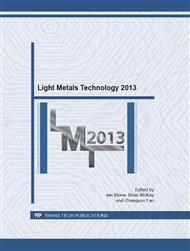[1]
S. Impey, D. Stephenson, J. Nicholls, The influence of surface preparation and pretreatments on the oxidation of liquid aluminium and aluminium-magnesium alloys, in: S.B. Newcomb, M.J. Bennett (Eds.), Microscopy of Oxidation 2: Second International Conference on the Microscopy of Oxidation, The Institue of Materials, Cambridge, 1993, pp.323-337.
DOI: 10.1201/9781003422020-31
Google Scholar
[2]
Z. Fan, Y. Wang, M. Xia, S. Arumuganathar, Enhanced heterogeneous nucleation in AZ91D alloy by intensive melt shearing, Acta Mater. 57 (2009) 4891-4901.
DOI: 10.1016/j.actamat.2009.06.052
Google Scholar
[3]
Y. Wang, Z. Fan, X. Zhou, G. Thompson, Characterisation of magnesium oxide and its interface with α-Mg in Mg–Al-based alloys, Phil. Mag. Letts. 91 (2011) 516-529.
DOI: 10.1080/09500839.2011.591744
Google Scholar
[4]
K. Kim, M. Watanabe, S. Kuroda, N. Kawano, Observation of high resolution microstructures in thermal sprayed coatings and single deposited splats using ion beam milling, Mater. Trans. 52 (2011) 439-446.
DOI: 10.2320/matertrans.t-m2010826
Google Scholar
[5]
T. Shih, I. Chen, Decomposition and reaction of thermal-formed alumina in aluminum alloy castings, Mater. Trans. 46 (2005) 1868-1876.
DOI: 10.2320/matertrans.46.1868
Google Scholar
[6]
L. Mondolfo, Aluminum Alloys: Structure and Properties, Butter Worths, London, 1976.
Google Scholar
[7]
W. Thiele, The oxidation of melts of aluminum and aluminum alloys, Aluminum 38 (1962) 707-715.
Google Scholar
[8]
K. Kim, M. Watanabe, K. Mitsuishi, K. Iakoubovskii, S. Kuroda, Impact bonding and rebounding between kinetically sprayed titanium particle and steel substrate revealed by high-resolution electron microscopy, J. Phys. D: Appl. Phys. 42 (2009) 065304.
DOI: 10.1088/0022-3727/42/6/065304
Google Scholar
[9]
A. Lohar, B. Mondal, S. Panigrahi, Influence of cooling rate on the microstructure and ageing behavior of as-cast Al–Sc–Zr alloy, J. Mater. Process Tech. 210 (2010) 2135-2141.
DOI: 10.1016/j.jmatprotec.2010.07.035
Google Scholar
[10]
N. Pourkia, M. Emamy, H. Farhangi, S. Ebrahimi, The effect of Ti and Zr elements and cooling rate on the microstructure and tensile properties of a new developed super high-strength aluminum alloy, Mat. Sci. Eng. A 527 (2010) 5318-5325.
DOI: 10.1016/j.msea.2010.05.009
Google Scholar
[11]
S. Kumar, N. Hari Babu, G. Scamans, Z. Fan, Microstructural evaluation of melt conditioned twin roll cast Al-Mg alloy, Mat. Sci. Tech. 27 (2011) 1833-1839.
DOI: 10.1179/1743284710y.0000000044
Google Scholar
[12]
M. Verweftf, On the precipiation of magnesium silicide in irradiated aluminium-magnesium alloys, Acta Mater. 48 (2000) 1097-1104.
DOI: 10.1016/s1359-6454(99)00417-6
Google Scholar


